Numerical Study on Vortical Flow Structure and Performance Enhancement of Centrifugal Compressor Impeller
Abstract
:1. Introduction
2. CFD Analysis and Vortex Visualization Method
2.1. Specification of CFD Analysis Model
2.2. Mathematical Model and Boundary Conditions
2.3. Vortex Visualization Method
2.4. Design Optimization Parameter
3. Results of Vortical Flow Structure Analysis
3.1. Comparison of 3D-RANS Analysis Results and Experimental Results
3.2. Vortical Flow Structure Analysis Results
3.3. Comparison of the Optimization Result with Conventional Centrifugal Compressor
4. Conclusions
Author Contributions
Funding
Data Availability Statement
Conflicts of Interest
References
- Tanç, B.; Arat, H.T.; Baltacıoğlu, E.; Aydın, K. Overview of the next quarter-century vision of hydrogen fuel cell electric vehicles. Int. J. Hydrogen. Energy 2019, 44, 10120–10128. [Google Scholar] [CrossRef]
- Yoshida, T.; Kojima, K. Toyota MIRAI Fuel Cell Vehicle and Progress Toward a Future Hydrogen Society. Electrochem. Soc. Interface 2015, 24, 45–49. [Google Scholar] [CrossRef]
- Ahluwalia, R.K.; Wang, X.; Rousseau, A.; Kumar, R. Fuel economy of hydrogen fuel cell vehicles. J. Power Sources 2004, 130, 192–201. [Google Scholar] [CrossRef]
- Yang, H.; Cho, K.S.; Park, C.Y.; Keon, D.B.; Lee, C.H.; Park, Y.S. The Novel Centrifugal Air Compressor Development for the Fuel Cell Electric Vehicles. In Proceedings of the SAE 2014 International Powertrain, Fuels & Lubricants Meeting, Birmingham, UK, 20–22 October 2022. [Google Scholar] [CrossRef]
- Borgstedt, P.; Neyer, B.; Schewe, G. Paving the road to electric vehicles—A patent analysis of the automotive supply industry. J. Clean. Prod. 2017, 167, 75–87. [Google Scholar] [CrossRef]
- Cagalitan, D.F.-D.; Abundo, M. A review of biohydrogen production technology for application towards hydrogen fuel cells. Renew. Sustain. Energy Rev. 2021, 151, 111413. [Google Scholar] [CrossRef]
- Hoffmann, P. Tomorrow’s Energy Hydrogen, Fuel Cells and the Prospects for a Cleaner Planet. Cogener. Distrib. Gener. J. 2006, 21, 76–77. [Google Scholar] [CrossRef]
- Zhang, Y.; Xu, S.; Wan, Y. Performance improvement of centrifugal compressors for fuel cell vehicles using the aerodynamic optimization and data mining methods. Int. J. Hydrogen Energy 2020, 45, 11276–11286. [Google Scholar] [CrossRef]
- Deng, Z.; Chen, Q.; Zhang, L.; Fu, Z. Data-driven NARMAX modeling for PEMFC air compressor. Int. J. Hydrogen Energy 2020, 45, 20321–20328. [Google Scholar] [CrossRef]
- Chen, H.; Zhuge, W.; Zhang, Y.; Ma, X.; Tao, L. Performance Improvement of a Centrifugal Compressor for the Fuel Cell Vehicle by Tip Leakage Vortex Control. J. Therm. Sci. 2021, 30, 2099–2111. [Google Scholar] [CrossRef]
- Chen, S.; Zuo, S.; Wei, K. Experimental and numerical investigations on the acoustic characteristics and unsteady behaviors of a centrifugal compressor for fuel cell vehicles. Proc. Inst. Mech. Eng. Part C J. Mech. Eng. Sci. 2021, 235, 1344–1356. [Google Scholar] [CrossRef]
- Cho, S.-Y.; Ahn, K.-Y.; Lee, Y.-D.; Kim, Y.-C. Optimal Design of a Centrifugal Compressor Impeller Using Evolutionary Algorithms. Math. Probl. Eng. 2012, 2012, 752931. [Google Scholar] [CrossRef]
- Tomita, I.; Ibaraki, S.; Furukawa, M.; Yamada, K. The Effect of Tip Leakage Vortex for Operating Range Enhancement of Centrifugal Compressor. J. Turbomach. 2013, 135, 649. [Google Scholar] [CrossRef]
- Ibaraki, S.; Furukawa, M.; Iwakiri, K.; Takahashi, K. Vortical Flow Structure and Loss Generation Process in a Transonic Centrifugal Compressor Impeller. In Proceedings of the Turbo Expo: Power for Land Sea and Air 2007, Parts A B, Montreal, QC, Canada, 14–17 May 2007; ASME: Windsdor, ON, Canada, 2007; Volume 6, pp. 1089–1098. [Google Scholar] [CrossRef]
- Wang, Z.; Wu, B.; Zhang, W. An Improved Method for Aerodynamic Design of Centrifugal Impeller Blades. In Proceedings of the Turbo Expo: Power for Land Sea and Air 2007, Parts A B, Orlando, FL, USA, 3–6 June 1991; ASME: Little Falls, NJ, USA, 1991; p. 8. [Google Scholar] [CrossRef]
- Casey, M.V. A Computational Geometry for the Blades and Internal Flow Channels of Centrifugal Compressors. J. Eng. Power. 1983, 105, 288–295. [Google Scholar] [CrossRef]
- Kim, H.-W.; Ryu, S.-H.; Ghal, S.-H.; Ha, J.-S. A Numerical Study on the Design And Flow Patterns of Compressor Impeller in a Marine Engine Turbocharger. In Proceedings of the ASME 2004 Internal Combustion Engine Division Fall Technical Conference, Long Beach, CA, USA, 24–27 October 2004; ASME: Little Falls, NJ, USA, 2004; pp. 309–314. [Google Scholar] [CrossRef]
- Bonaiuti, D.; Arnone, A.; Ermini, M.; Baldassarre, L. Analysis and Optimization of Transonic Centrifugal Compressor Impellers Using the Design of Experiments Technique. J. Turbomach. 2006, 128, 786–797. [Google Scholar] [CrossRef]
- ANSYS, Inc. ANSYS CFX-Solver Theory Guide; ANSYS, Inc.: Canonsburg, PA, USA, 2011. [Google Scholar]
- Menter, F.R. Zonal Two Equation k-ω Turbulence Models for Aerodynamic Flows. In Proceedings of the 23rd Fluid Dynamics, Plasmadynamics, and Lasers Conference, Orlando, FL, USA, 6–9 July 1993; American Institute of Aeronautics and Astronautics: Sunrise Vallery, VA, USA, 1993; pp. 1–22. [Google Scholar]
- Martos, P.A.; Barrera-Medrano, M.E.; Martinez-Botas, R.; Tomita, I.; Kanzaka, T.; Ibaraki, S. Flow Field Analysis and Enhanced Design of a Centrifugal Compressor Volute. In Proceedings of the ASME Turbo Expo 2021: Turbomachinery Technical Conference and Exposition, Virtual Online, 7–11 June 2021; Volume 2C: Turbomachinery—Design Methods and CFD Modeling for Turbomachinery; Ducts, Noise, and Component Interactions. ASME: Little Falls, NJ, USA, 2021. [Google Scholar] [CrossRef]
- Ou, M.; Yan, L.; Huang, W.; Li, S.-B.; Li, L.-Q. Detailed parametric investigations on drag and heat flux reduction induced by a combinational spike and opposing jet concept in hypersonic flows. Int. J. Heat Mass Transf. 2018, 126, 10–31. [Google Scholar] [CrossRef]
- Borm, O.; Kau, H.-P. Unsteady Aerodynamics of a Centrifugal Compressor Stage: Validation of Two Different CFD Solvers. In Proceedings of the ASME Turbo Expo 2012: Turbine Technical Conference and Exposition, Copenhagen, Denmark, 11–15 June 2012; Turbomachinery, Parts A, B, and C. ASME: Little Falls, NJ, USA, 2012; Volume 8, pp. 2753–2764. [Google Scholar] [CrossRef] [Green Version]
- Sawada, K. Convenient visualization method for identifying vortex centers. Trans. Jpn. Soc. Aeronaut. Space Sci. 1995, 38, 102–116. [Google Scholar]
- Iwakiri, K.; Furukawa, M.; Ibaraki, S.; Tomita, I. Unsteady and Three-Dimensional Flow Phenomena in a Transonic Centrifugal Compressor Impeller at Rotating Stall. In Proceedings of the ASME Turbo Expo 2009: Power for Land, Sea, and Air, Orlando, FL, USA, 8–12 June 2009; Turbomachinery, Parts A and B. ASME: Little Falls, NJ, USA, 2009; Volume 7, pp. 1611–1622. [Google Scholar] [CrossRef]
- Itou, S.; Oka, N.; Furukawa, M.; Yamada, K.; Ibaraki, S.; Iwakiri, K.; Hayashi, Y. Optimum aerodynamic design of centrifugal compressor using a genetic algorithm and an inverse method based on meridional viscous flow analysis. In Proceedings of the 17th International Symposium on Transport Phenomena and Dynamics of Rotating Machinery, Maui, HI, USA, 16–21 December 2017; (ISROMAC2017). pp. 1–9. Available online: https://hal.archives-ouvertes.fr/hal-02981000 (accessed on 7 July 2022).
- Yamada, K.; Furukawa, M.; Arai, H.; Kanzaki, D. Evolution of Reverse Flow in a Transonic Centrifugal Compressor at Near-Surge. In Turbo Expo: Power for Land, Sea, and Air; ASME: Little Falls, NJ, USA, 2017; Volume 50800, p. V02CT44A014. [Google Scholar] [CrossRef]
- Righi, M.; Pachidis, V.; Könözsy, L. On the prediction of the reverse flow and rotating stall characteristics of high-speed axial compressors using a three-dimensional through-flow code. Aerosp. Sci. Technol. 2020, 99, 105578. [Google Scholar] [CrossRef]
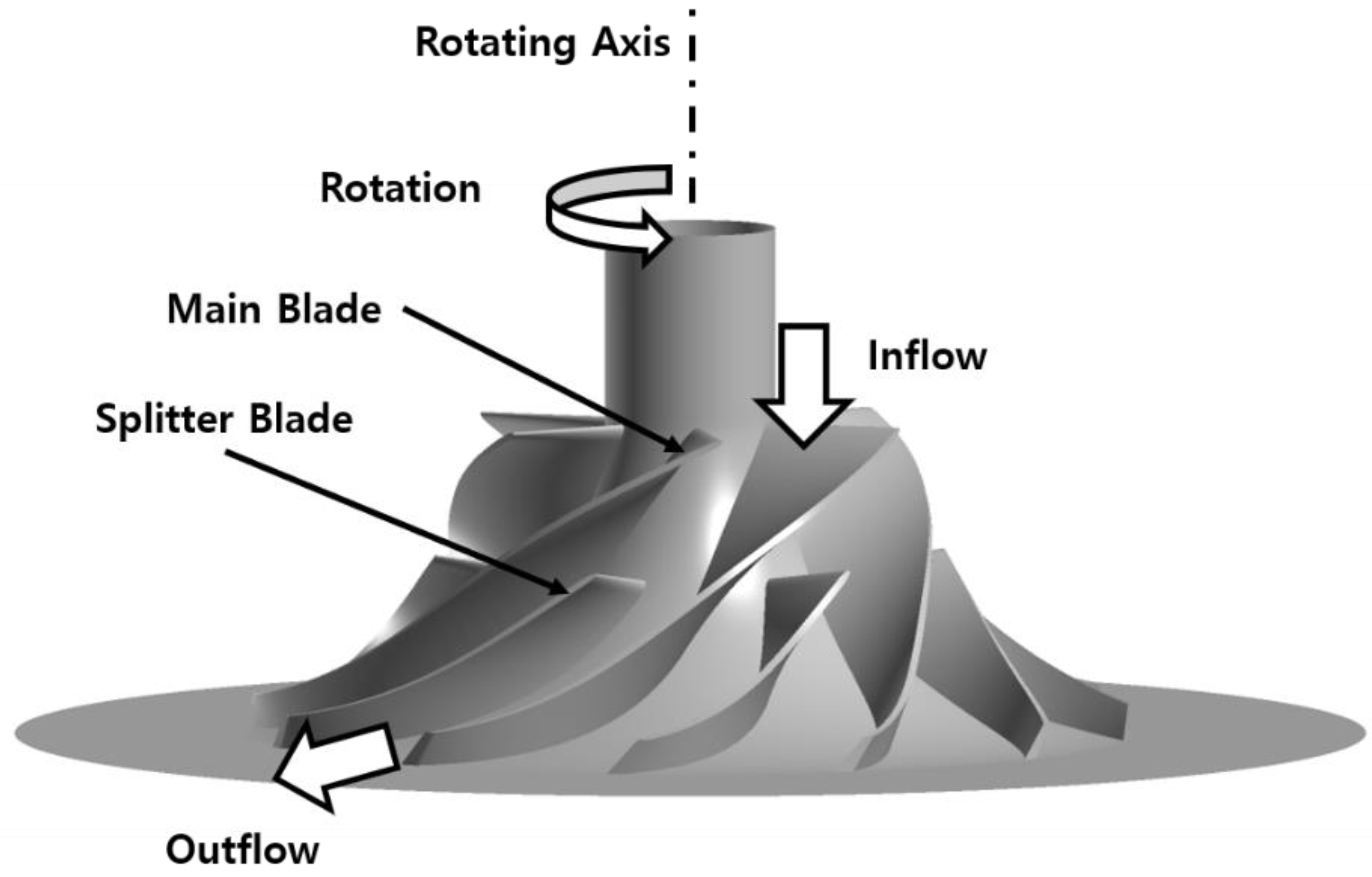
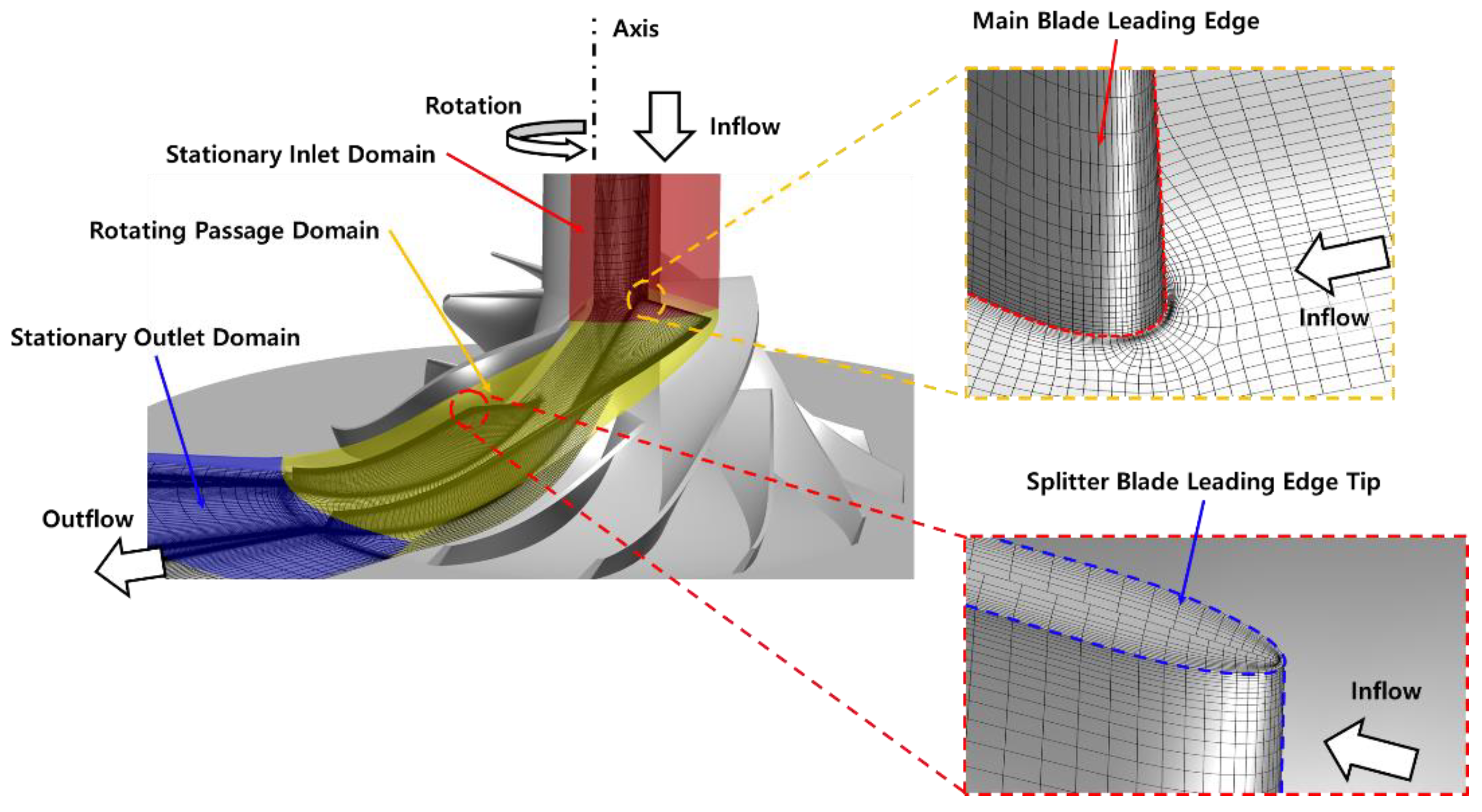
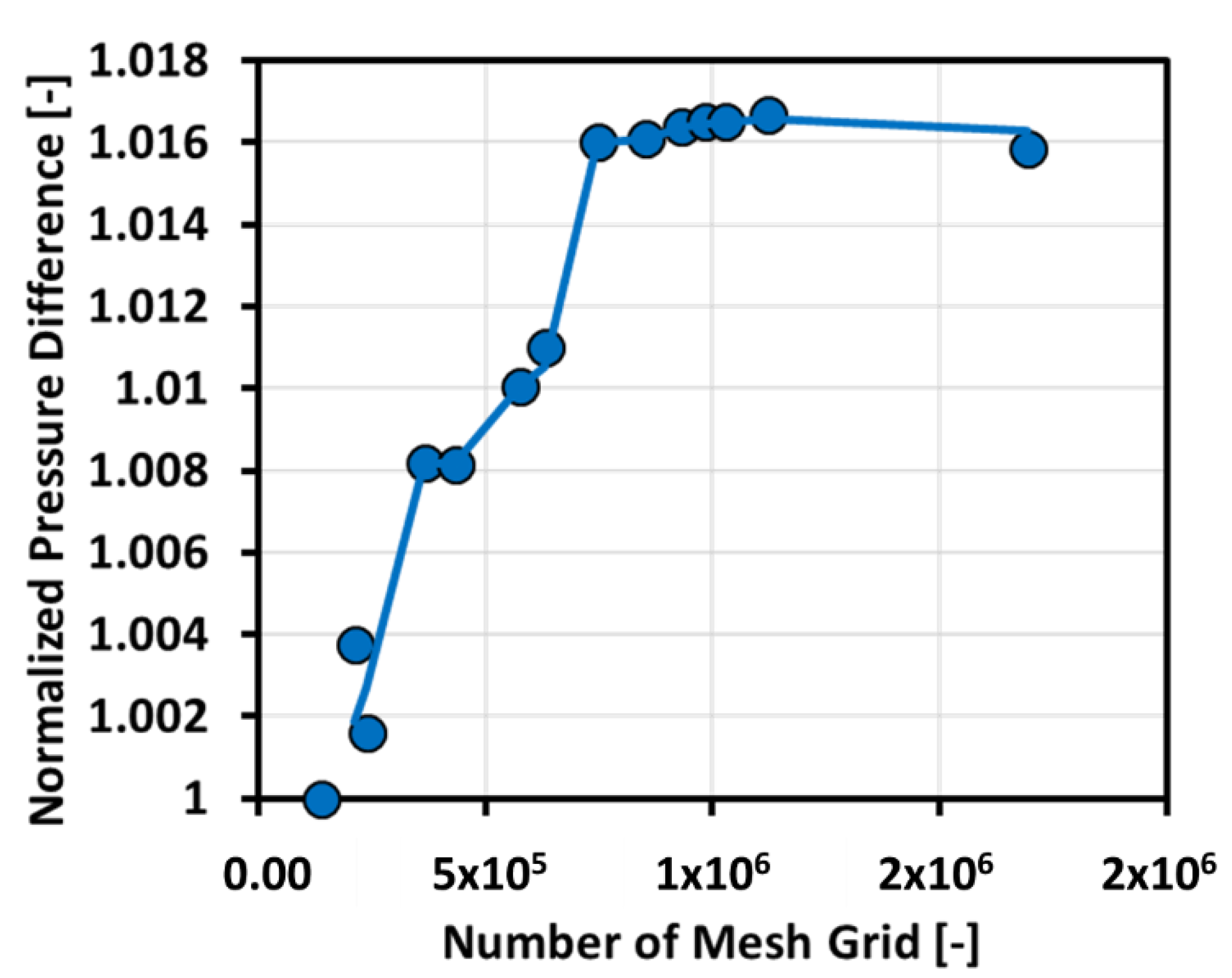
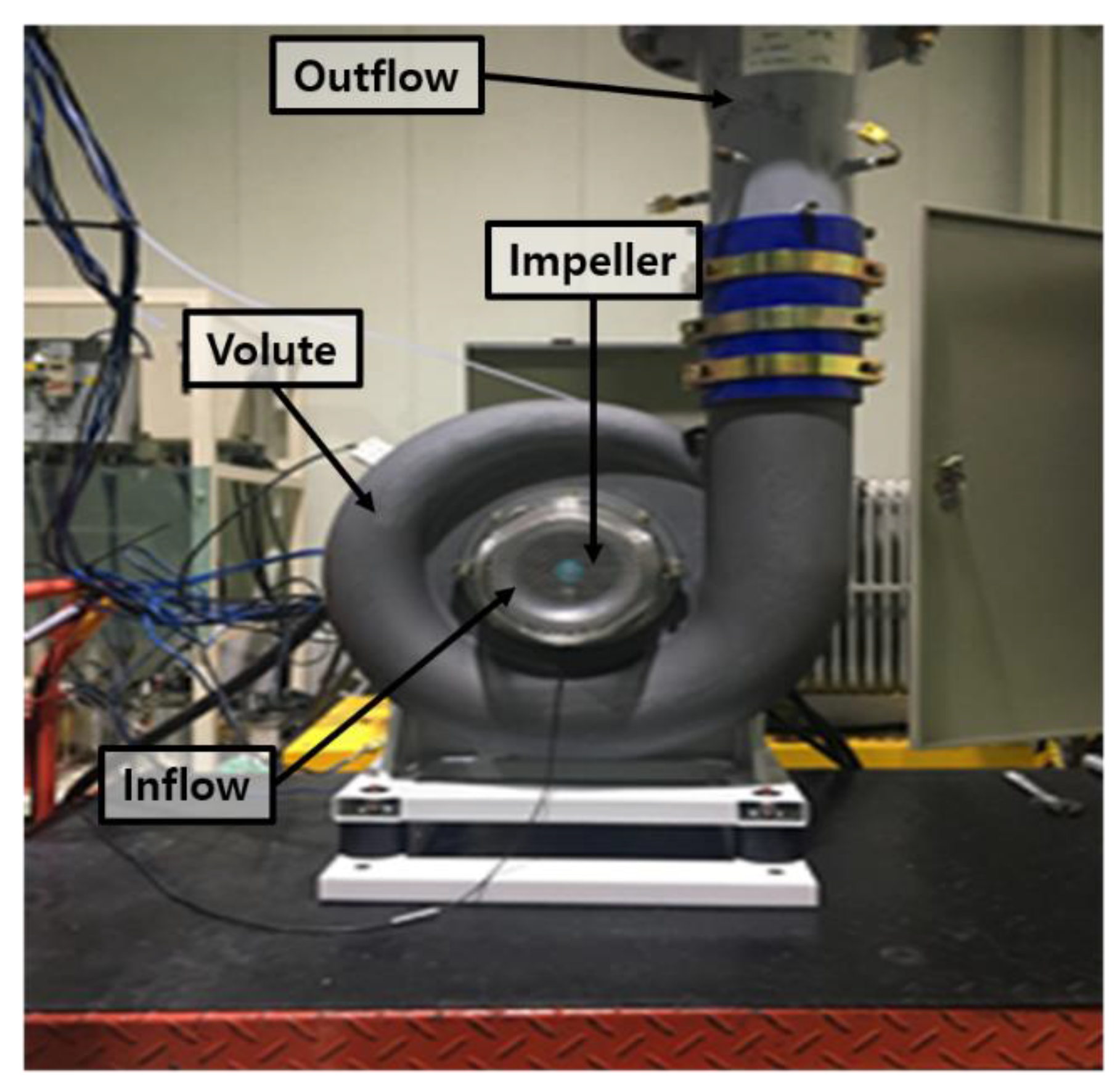
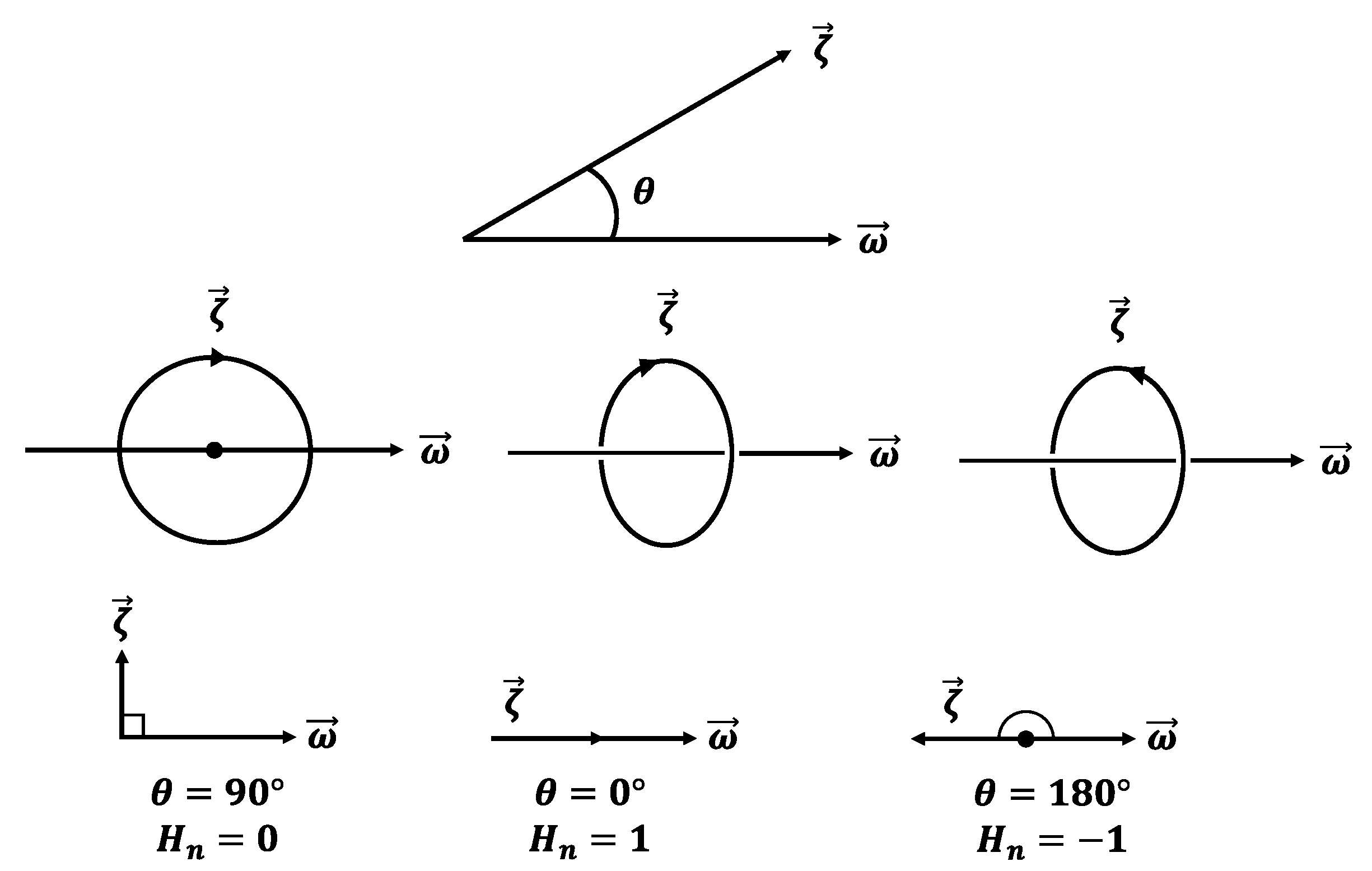
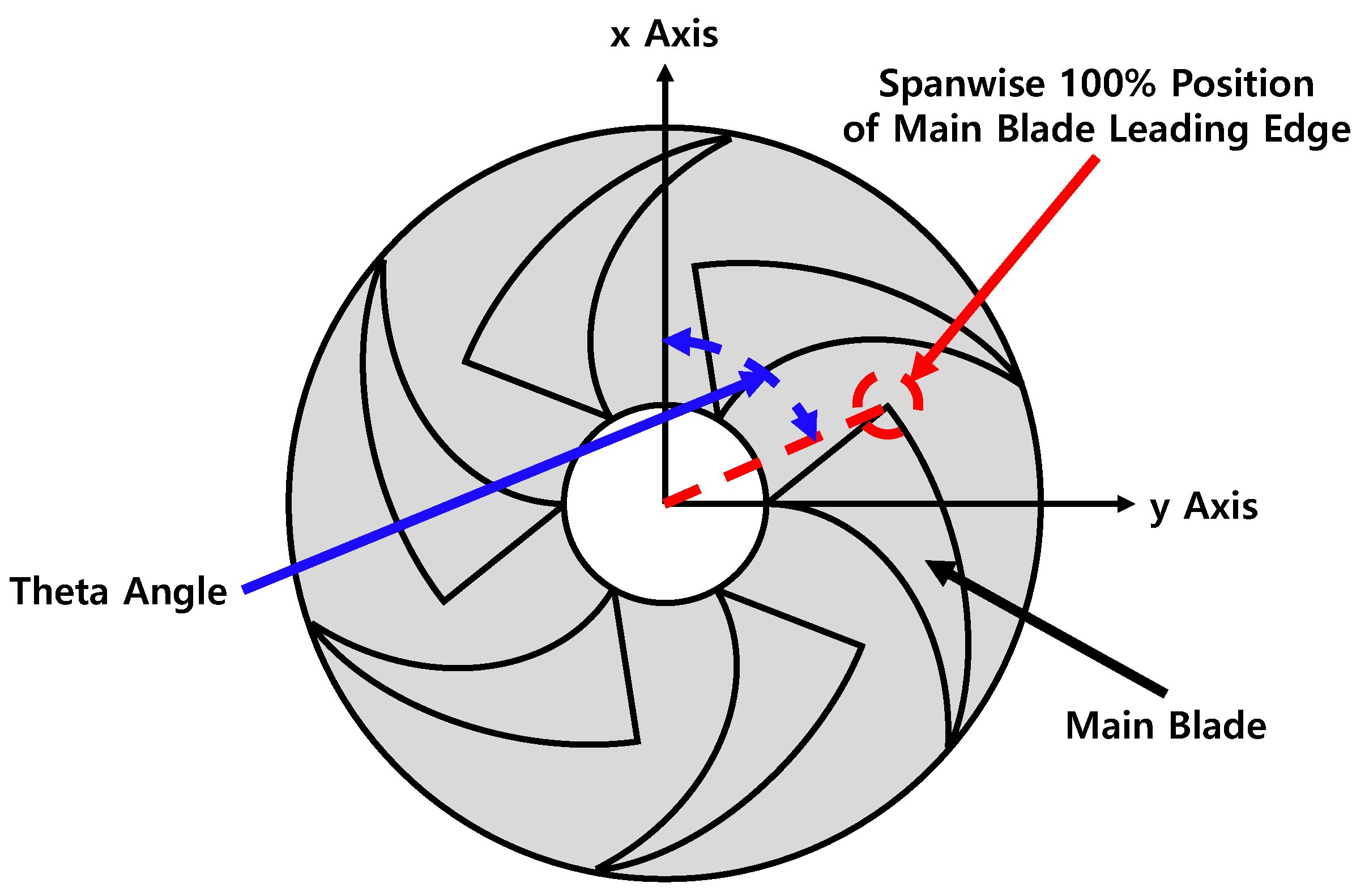
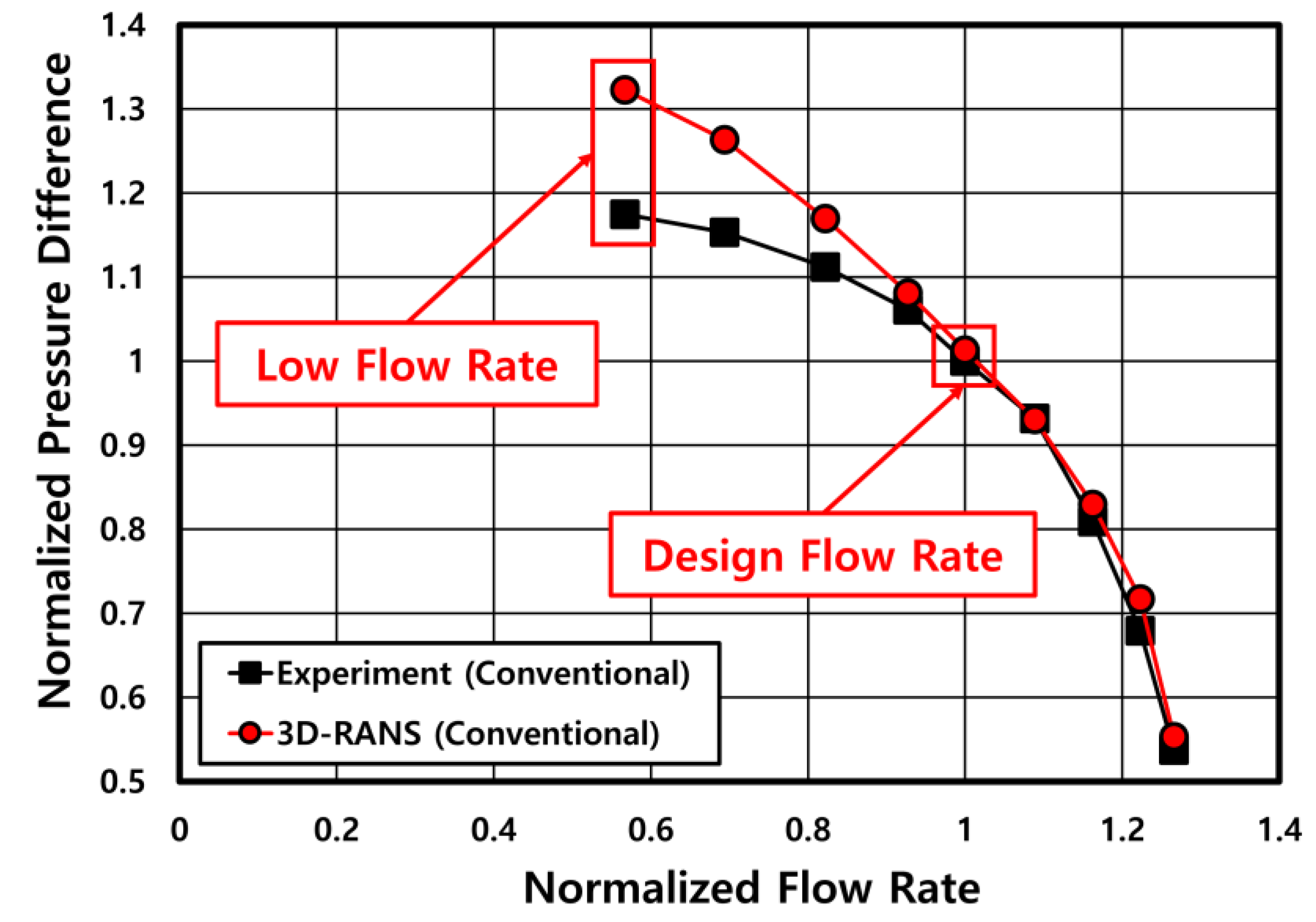

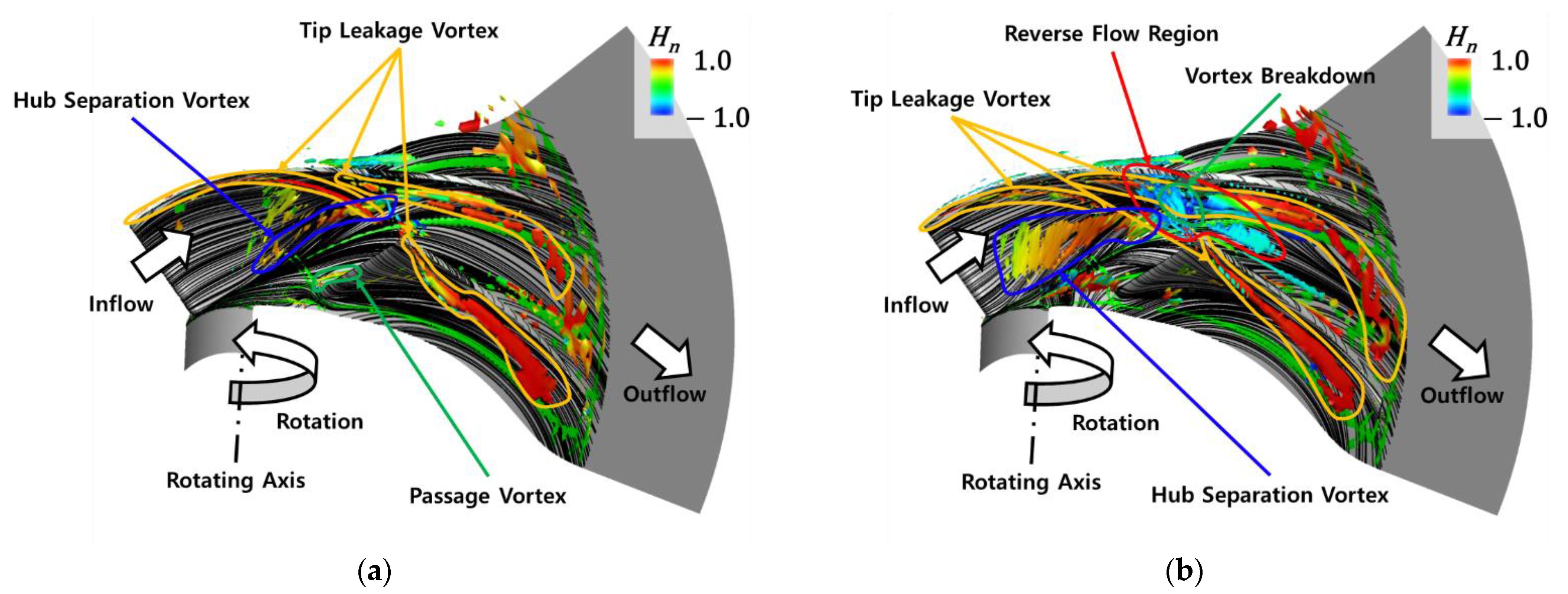

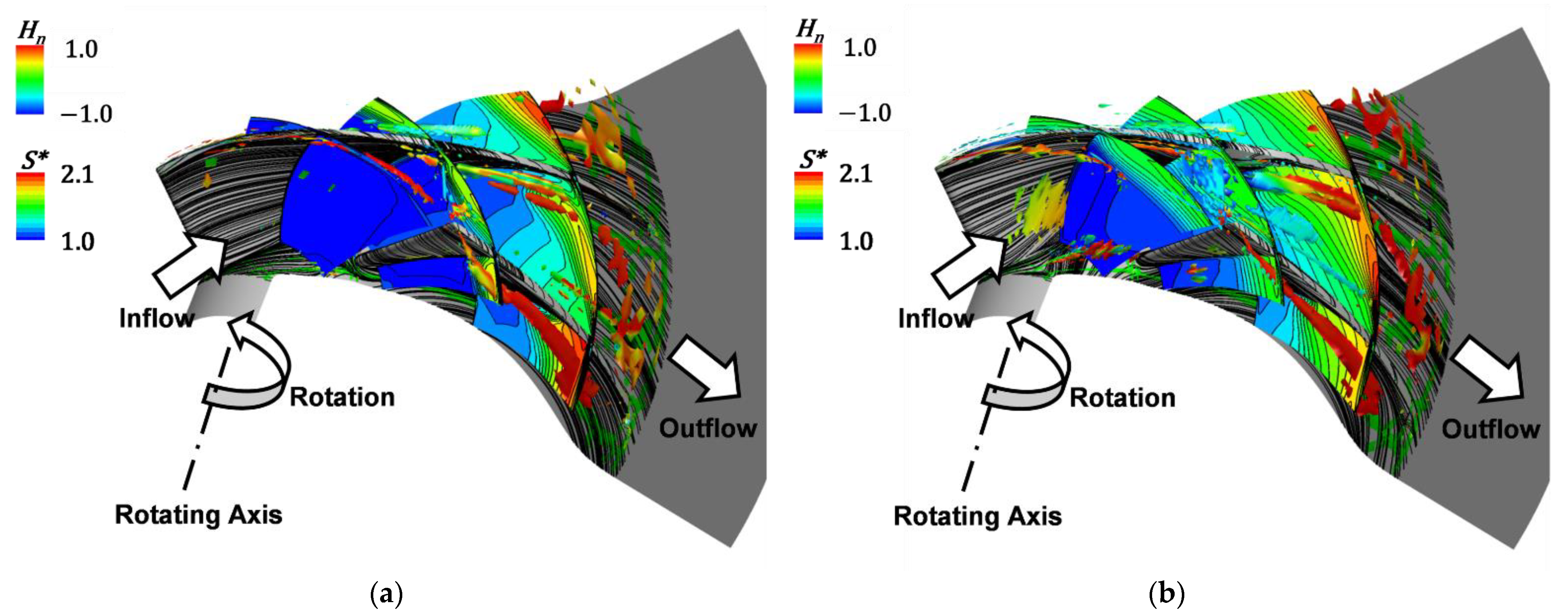
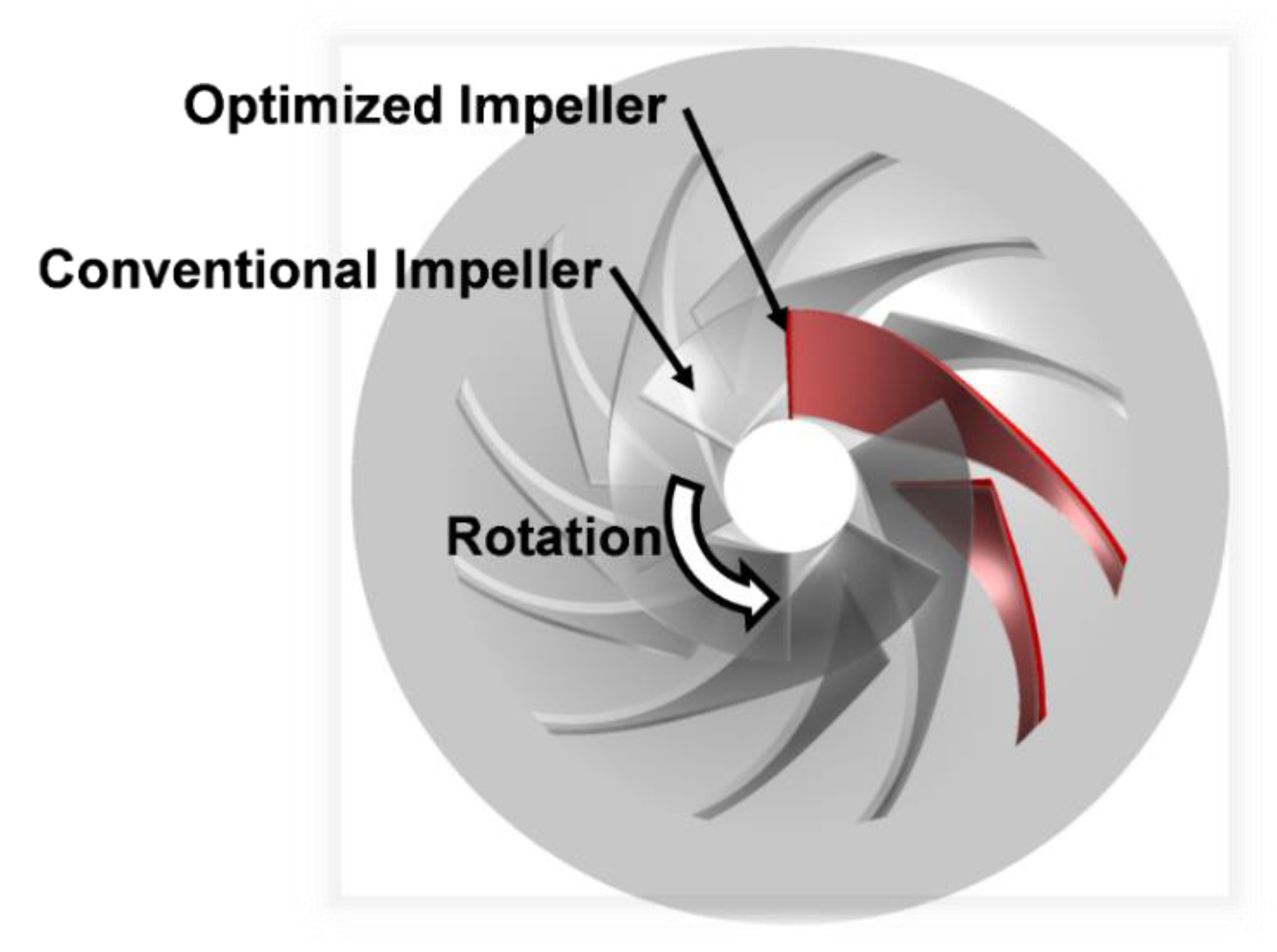
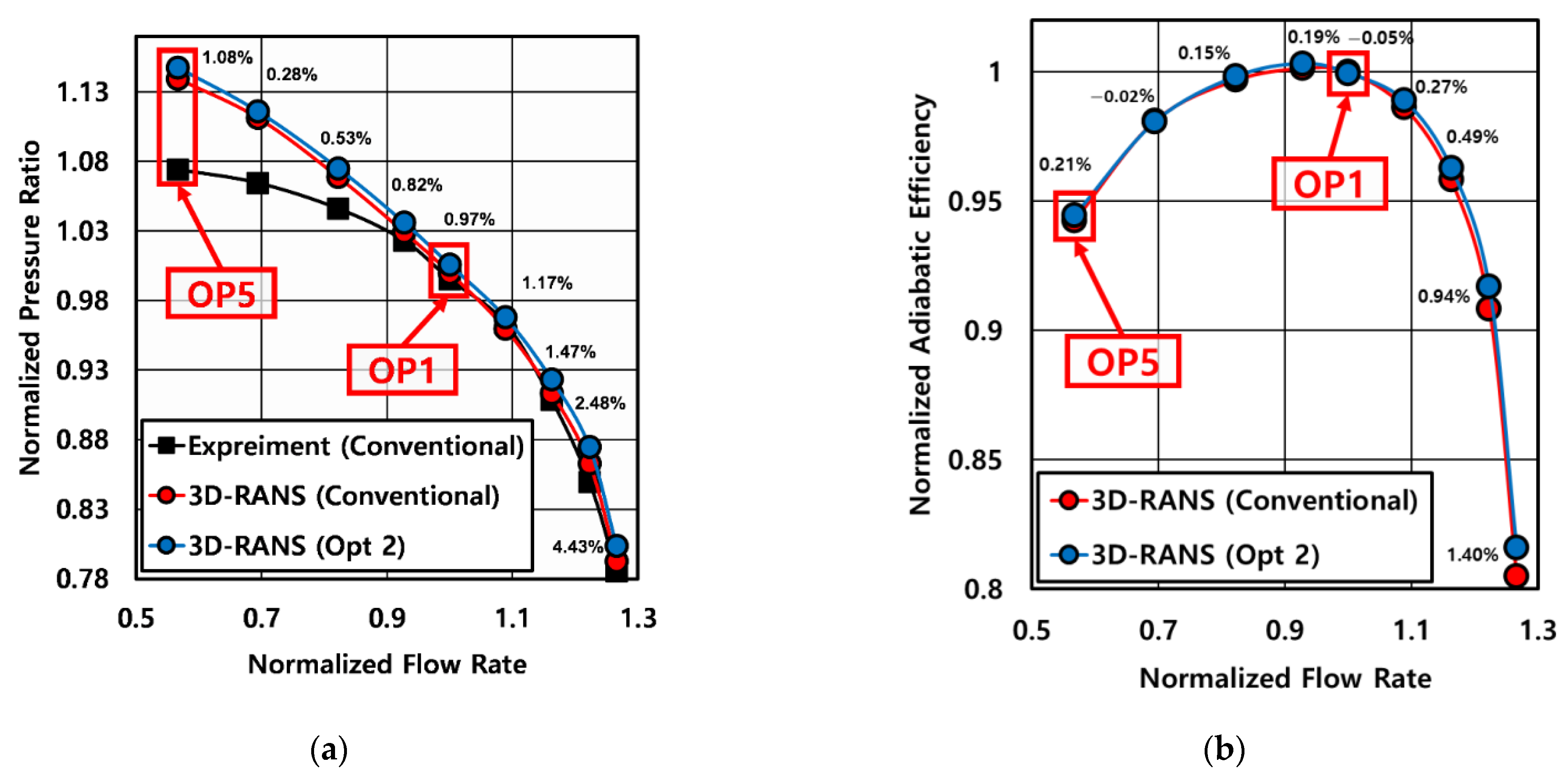
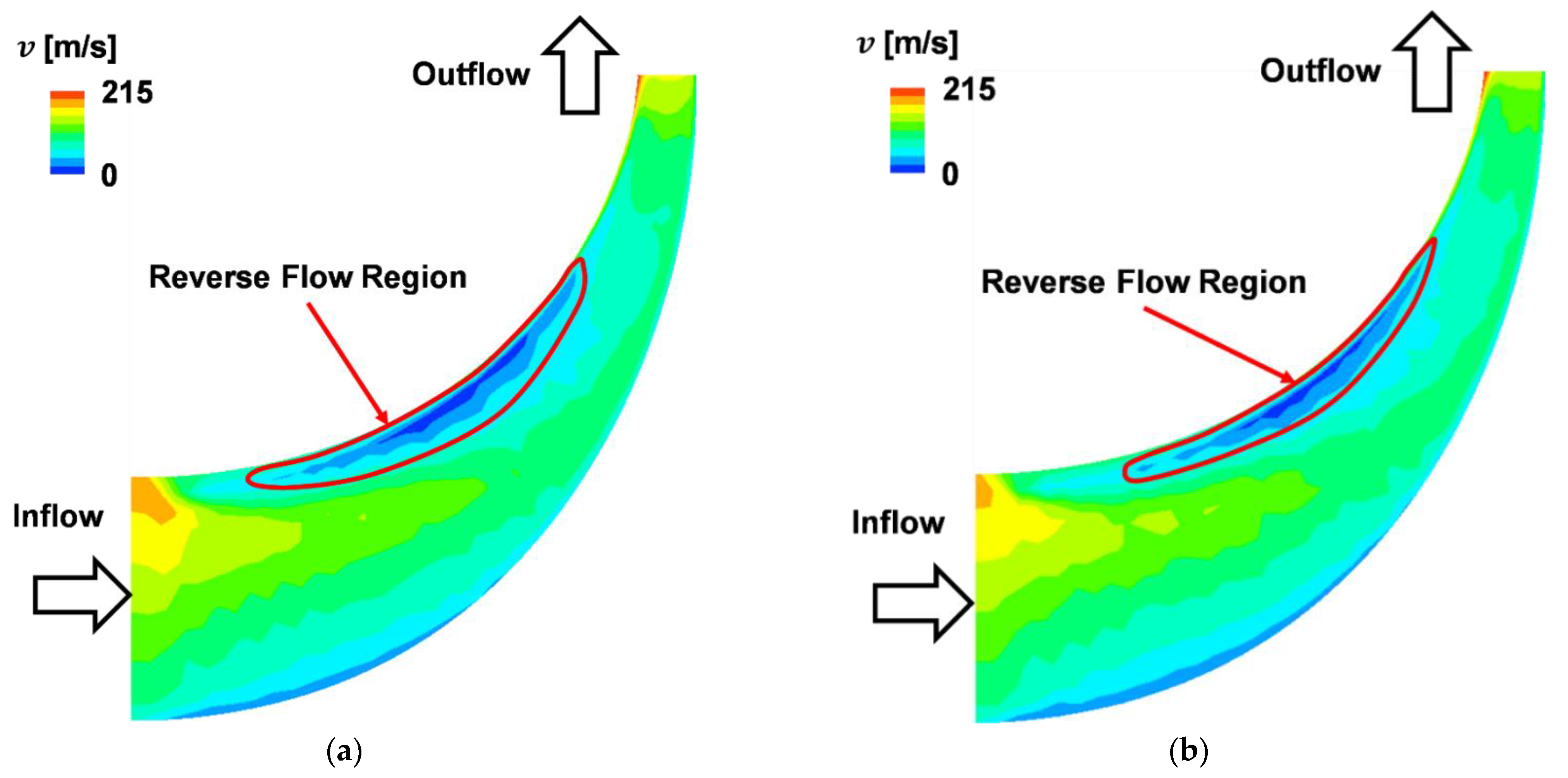
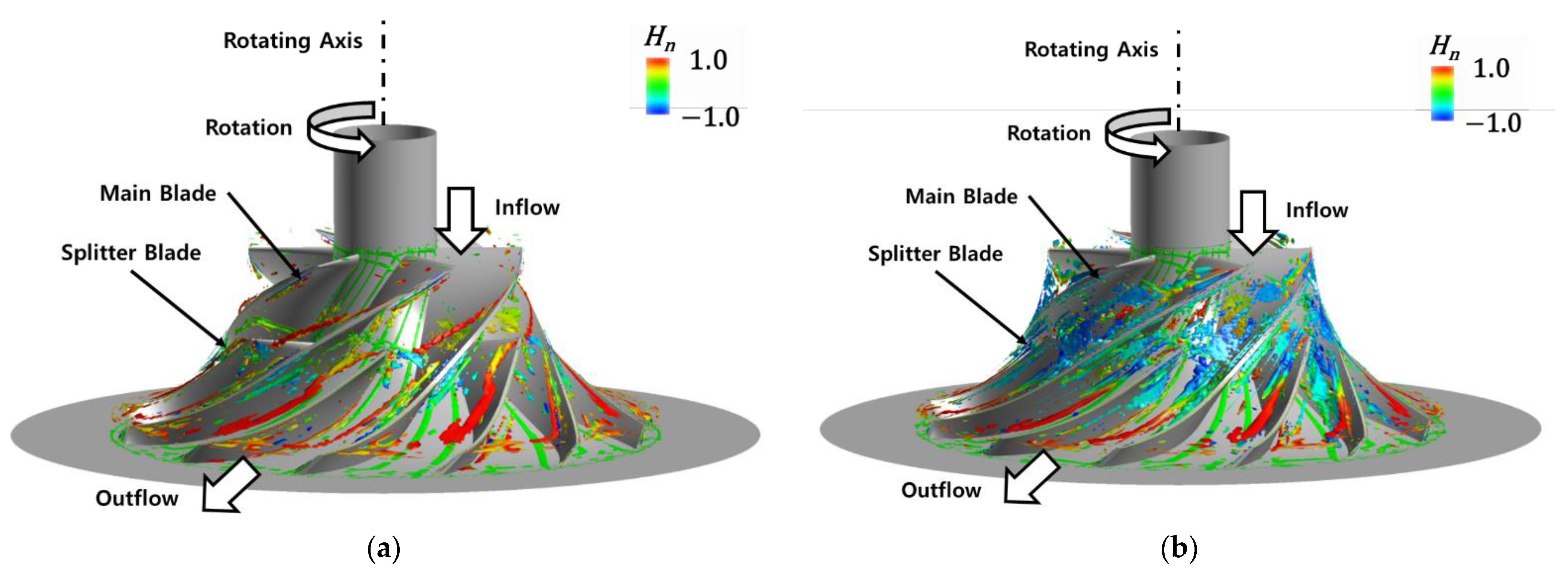
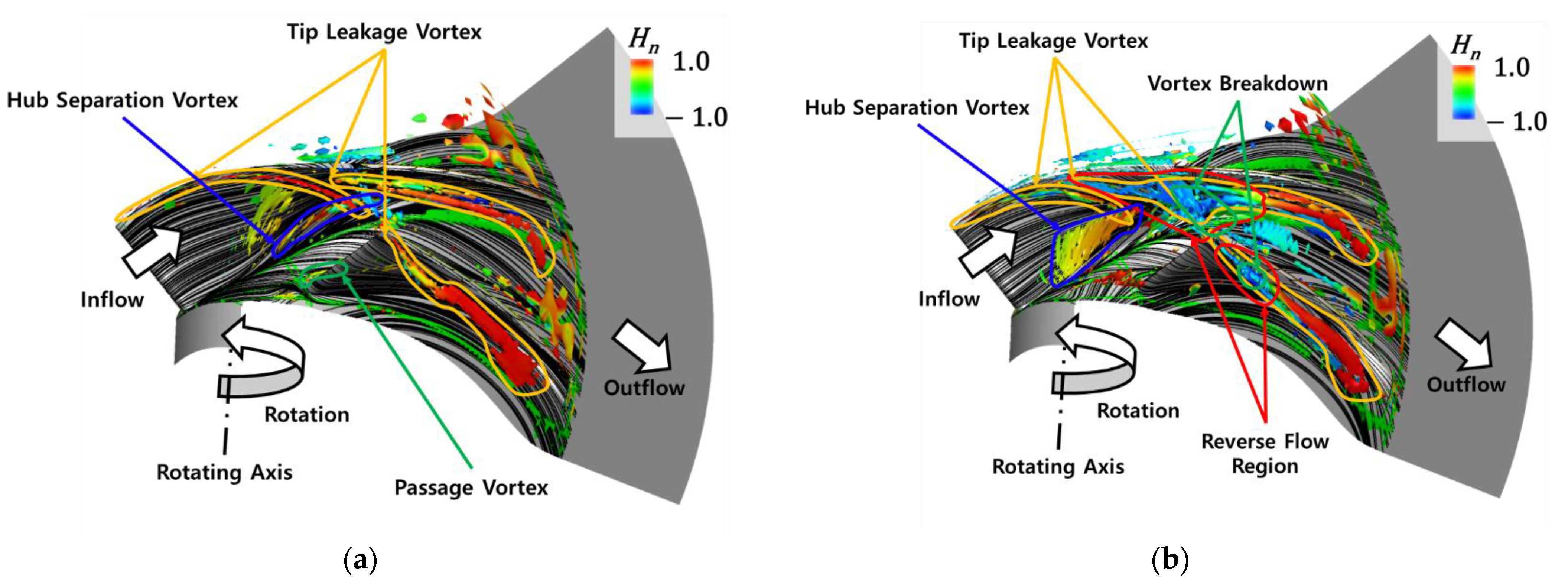

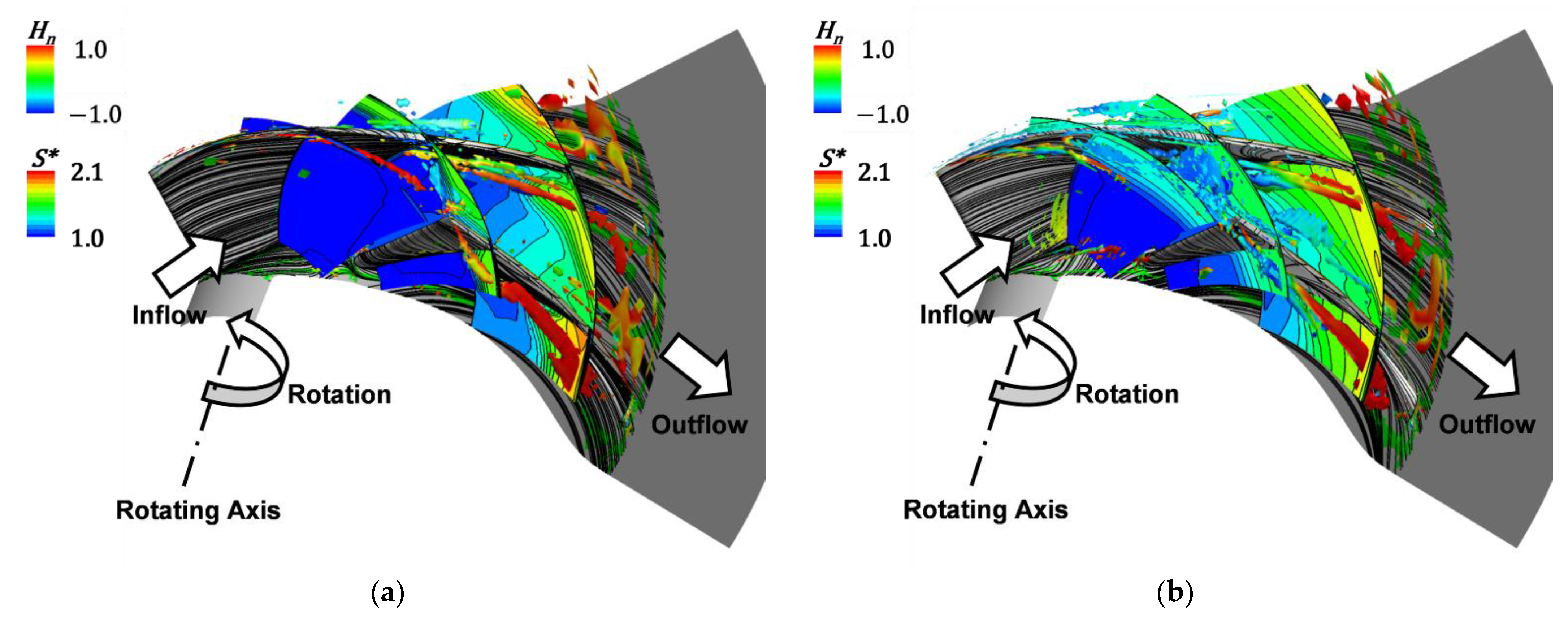
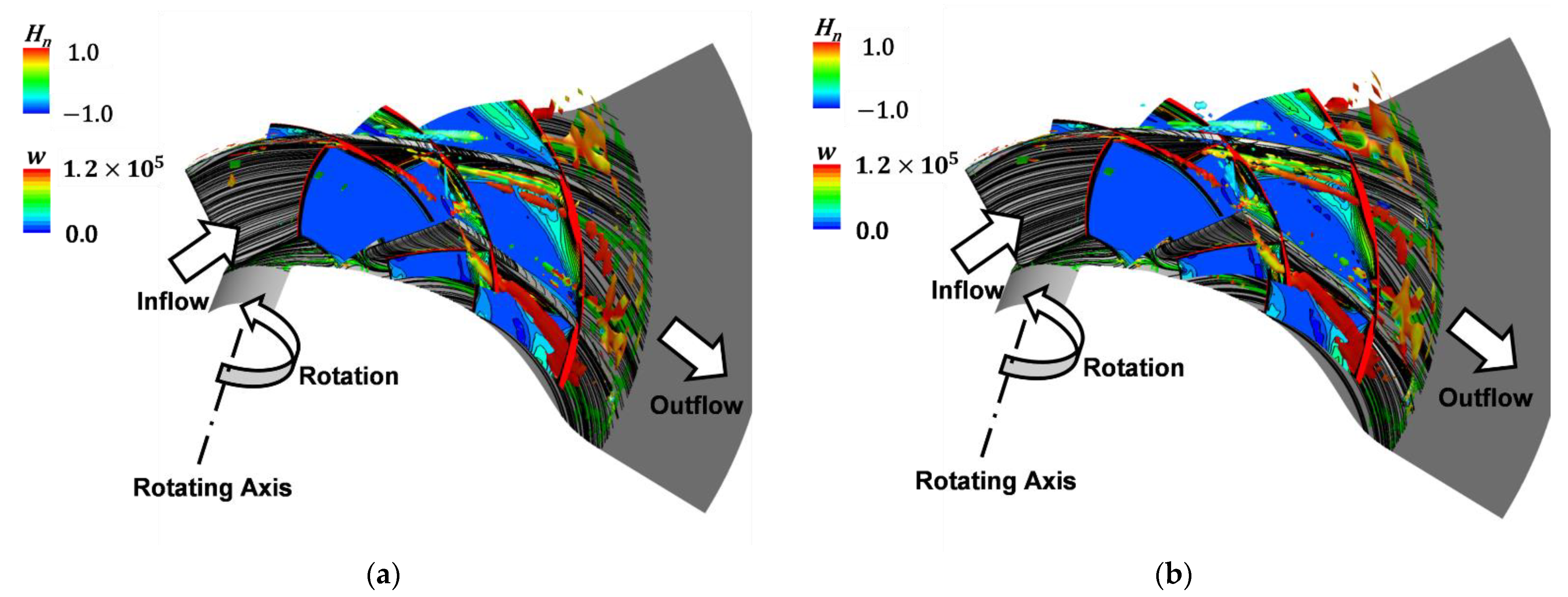
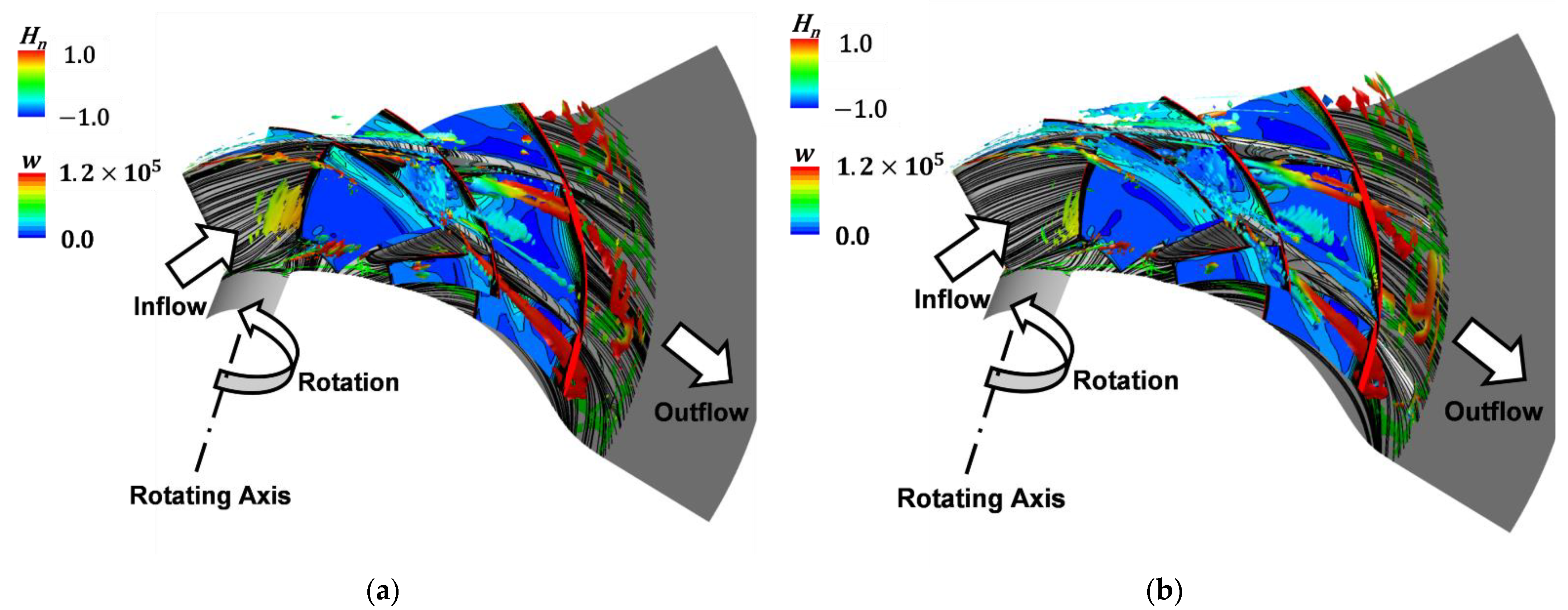
| Design Parameter | Value (Dimensionless) |
|---|---|
| Impeller Diameter | 1 |
| Impeller Height | 0.3546 |
| Number of Main Blade | 6 |
| Number of Splitter Blade | 6 |
| Tip Clearance | 0.00319 |
| Case | Theta Angle Difference at Spanwise 0% | Theta Angle Difference at Spanwise 100% |
|---|---|---|
| Conventional | 0° | 0° |
| Opt. 1 | 0° | −1° |
| Opt. 2 | 0° | −2° |
| Opt. 3 | 0° | −3° |
| Opt. 4 | 0° | −4° |
| Case | Normalized Efficiency Difference at Design Flow Rate | Normalized Efficiency Difference at Low Flow Rate |
|---|---|---|
| Opt. 1 | −0.34% | −0.36% |
| Opt. 2 | −0.05% | 0.21% |
| Opt. 3 | 0.00% | 0.00% |
| Opt. 4 | 0.07% | 0.00% |
Publisher’s Note: MDPI stays neutral with regard to jurisdictional claims in published maps and institutional affiliations. |
© 2022 by the authors. Licensee MDPI, Basel, Switzerland. This article is an open access article distributed under the terms and conditions of the Creative Commons Attribution (CC BY) license (https://creativecommons.org/licenses/by/4.0/).
Share and Cite
Hong, S.; Mugabi, J.; Jeong, J.-H. Numerical Study on Vortical Flow Structure and Performance Enhancement of Centrifugal Compressor Impeller. Appl. Sci. 2022, 12, 7755. https://doi.org/10.3390/app12157755
Hong S, Mugabi J, Jeong J-H. Numerical Study on Vortical Flow Structure and Performance Enhancement of Centrifugal Compressor Impeller. Applied Sciences. 2022; 12(15):7755. https://doi.org/10.3390/app12157755
Chicago/Turabian StyleHong, Seongbin, Jophous Mugabi, and Jae-Ho Jeong. 2022. "Numerical Study on Vortical Flow Structure and Performance Enhancement of Centrifugal Compressor Impeller" Applied Sciences 12, no. 15: 7755. https://doi.org/10.3390/app12157755
APA StyleHong, S., Mugabi, J., & Jeong, J.-H. (2022). Numerical Study on Vortical Flow Structure and Performance Enhancement of Centrifugal Compressor Impeller. Applied Sciences, 12(15), 7755. https://doi.org/10.3390/app12157755








